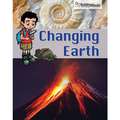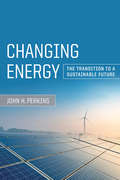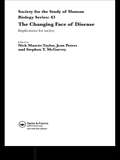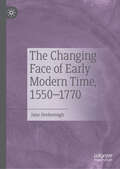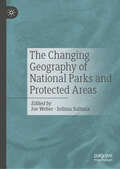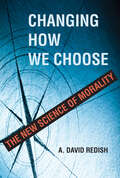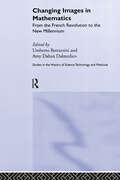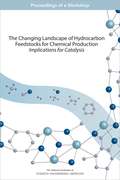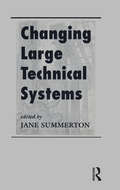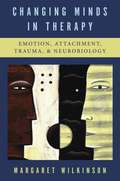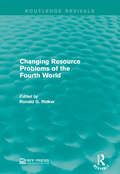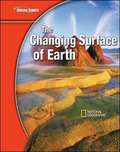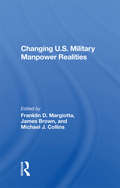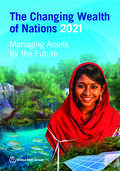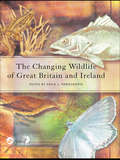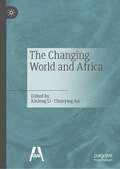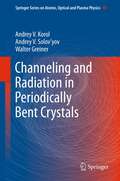- Table View
- List View
Changing Earth
by Janette SchusterNIMAC-sourced textbook <p><p> Changing Earth introduces students to the earth science concept of how the distinct features of Earth came to be.
Changing Energy: The Transition to a Sustainable Future
by John H. PerkinsChanging Energy outlines how humanity established the current energy economy through three previous transitions, and how we now stand poised for a necessary fourth transition. Human societies around the globe have received immense benefits from uses of coal, oil, gas, and uranium sources, yet we must now rebuild our energy economies to rely on renewable sources and use them efficiently. The imperative for a fourth energy transition comes from dangers related to climate change, geopolitical tensions, documented health and environmental effects, and long-term depletion of today’s sources. John H. Perkins argues that a future in which current levels of energy service benefits are sustained can come only from investments in the technologies needed to bring about a fourth energy transition. Changing Energy envisions a viable post–fossil fuel economy and identifies the barriers to be overcome.
The Changing Face of Disease: Implications for Society (Society For The Study Of Human Biology Ser.)
by Nick Mascie-Taylor Jean Peters Stephen T. McGarveyDisease is an ever-present threat faced by all human societies. Today, this concept has become an influential area of study known as the global burden of disease, which encompasses contemporary health concerns such as the economic costs of disease, the societal impact of illness in developing nations, and infectious diseases resulting from lifestyl
The Changing Face of Early Modern Time, 1550–1770
by Jane DesboroughThis book provides a reinterpretation of early modern clock and watch dials on the basis of use. Between 1550 and the emergence of a standard format in 1770, dials represented combinations of calendrical, lunar and astronomical information using multiple concentric rings, subsidiary dials and apertures. Change was gradual, but significant. Over the course of eight chapters and with reference to thirty-five exceptional images, this book unlocks the meaning embedded within these early combinations. The true significance of dial change can only be fully understood by comparing dials with printed paper sources such as almanacs, diagrams and craft pamphlets. Clock and watch makers drew on traditional communication methods, utilised different formats to generate trust in their work, and tried to be help users in different contexts. The calendar, lunar and astronomical functions were useful as a memory prompt for astrology up until the mid-late seventeenth century. After the decline of this practice, the three functions continued to be useful for other purposes, but eventually declined.
The Changing Geography of National Parks and Protected Areas
by Joe Weber Selima SultanaThis book contains recent geographic work examining the changing geography of protected areas in the U.S. and Europe. These places can be national parks, forests, or other places that are being protected for their significant aesthetic, historical, or environmental values by governments and communities. These places can be studied with reference to their physical environments, the management of their plant and animal life, which places are to be protected, who visits these places (and who does not, and why not), and how we think of these places. This work includes examinations of many parks and issues that affect them, such as land degradation, the social and political geography involved in creating new national park units, visitation by underserved segments of the population, and the changing names of protected areas. It makes use of work using methods and data as diverse as remote sensing, nineteenth survey plats and GIS, and online visitor surveys.
Changing Habitats
by Smithsonian InstitutionChanging Habitats is part of the Smithsonian Science Stories™ Literacy Series and has on-grade and below-grade leveled readers available to accommodate a range of readers in an elementary classroom. The line and dot graphic at the bottom of the front cover indicates the reading level. When the dot is at the top of the line, the reading level for the book is on-grade. When it is at the bottom, the book is below-grade. You can also find the official Lexile Scores for each reading in the Table of Contents. The books in this literacy series enhance and reinforce the science concepts taught in the Smithsonian Science for the Classroom™ curriculum units.
Changing How We Choose: The New Science of Morality
by A. David RedishThe &“new science of morality&” that will change how we see each other, how we build our communities, and how we live our lives.In Changing How We Choose, David Redish makes a bold claim: Science has &“cracked&” the problem of morality. Redish argues that moral questions have a scientific basis and that morality is best viewed as a technology—a set of social and institutional forces that create communities and drive cooperation. This means that some moral structures really are better than others and that the moral technologies we use have real consequences on whether we make our societies better or worse places for the people living within them. Drawing on this new scientific definition of morality and real-world applications, Changing How We Choose is an engaging read with major implications for how we see each other, how we build our communities, and how we live our lives.Many people think of human interactions in terms of conflicts between individual freedom and group cooperation, where it is better for the group if everyone cooperates but better for the individual to cheat. Redish shows that moral codes are technologies that change the game so that cooperating is good for the community and for the individual. Redish, an authority on neuroeconomics and decision-making, points out that the key to moral codes is how they interact with the human decision-making process. Drawing on new insights from behavioral economics, sociology, and neuroscience, he shows that there really is a &“new science of morality&” and that this new science has implications—not only for how we understand ourselves but also for how we should construct those new moral technologies.
Changing Images in Mathematics: From the French Revolution to the New Millennium (Routledge Studies in the History of Science, Technology and Medicine #13)
by Umberto Bottazzini Amy Dahan DalmedicoThis book focuses on some of the major developments in the history of contemporary (19th and 20th century) mathematics as seen in the broader context of the development of science and culture. Avoiding technicalities, it displays the breadth of contrasting images of mathematics favoured by different countries, schools and historical movements, showing how the conception and practice of mathematics changed over time depending on the cultural and national context. Thus it provides an original perspective for embracing the richness and variety inherent in the development of mathematics. Attention is paid to the interaction of mathematics with themes whose proper treatment have been neglected by the traditional historiography of the discipline, such as the relationship between mathematics, statistics and medicine.
The Changing Landscape of Hydrocarbon Feedstocks for Chemical Production: Proceedings of a Workshop
by National Academies of Sciences Engineering MedicineA decade ago, the U.S. chemical industry was in decline. Of the more than 40 chemical manufacturing plants being built worldwide in the mid-2000s with more than 1$ billion in capitalization, none were under construction in the United States. Today, as a result of abundant domestic supplies of affordable natural gas and natural gas liquids resulting from the dramatic rise in shale gas production, the U.S. chemical industry has gone from the world’s highest-cost producer in 2005 to among the lowest-cost producers today. The low cost and increased supply of natural gas and natural gas liquids provides an opportunity to discover and develop new catalysts and processes to enable the direct conversion of natural gas and natural gas liquids into value-added chemicals with a lower carbon footprint. The economic implications of developing advanced technologies to utilize and process natural gas and natural gas liquids for chemical production could be significant, as commodity, intermediate, and fine chemicals represent a higher-economic-value use of shale gas compared with its use as a fuel. To better understand the opportunities for catalysis research in an era of shifting feedstocks for chemical production and to identify the gaps in the current research portfolio, the National Academies of Sciences, Engineering, and Medicine conducted an interactive, multidisciplinary workshop in March 2016. The goal of this workshop was to identify advances in catalysis that can enable the United States to fully realize the potential of the shale gas revolution for the U.S. chemical industry and, as a result, to help target the efforts of U.S. researchers and funding agencies on those areas of science and technology development that are most critical to achieving these advances. This publication summarizes the presentations and discussions from the workshop.
Changing Large Technical Systems
by Jane SummertonThis international anthology presents case studies of historical and contemporary transformations of large technical systems such as railways, telecommunications, electricity, and automobiles. The authors, working at the forefront of historical and social science research on the dynamics of large technical systems, analyze how and why these systems undergo change. Because of their important roles in contemporary society, large technical systems such as railways, airlines, road systems, telecommunications, and electric power network share drawing considerable academic and political interest. In this collaborative study on processes of change in large technical systems, the contributing authors present historical and current case studies of transformation within these systems. Working at the forefront of historical and social science research on the dynamics of large technical systems, the authors specifically analyze how and why the systems undergo change. In some cases, new technologies are solving old problems and presenting opportunities for system growth. In other areas, new regulatory approaches have brought competition and deregulation, often posing challenges to system builders. The authors also show how the breakup of national boundaries and new corporate strategies for global management of technology are transforming systems in ways that will have significant impacts on all consumers
Changing Minds in Therapy: Emotion, Attachment, Trauma, and Neurobiology (Norton Series on Interpersonal Neurobiology)
by Margaret WilkinsonAddresses the flurry of questions about the practical application of neuroscience in clinical treatment. Recent advances in research in the fields of attachment, trauma, and the neurobiology of emotion have shown that mind, brain, and body are inextricably linked. This new research has revolutionized our understanding of the process of change in psychotherapy and in life, and raised a flurry of questions about the practical application of neuroscience in clinical treatment, particularly with those who have experienced early relational trauma and neglect. What insight does neuroscience offer to our clinical understanding of early life experiences? Can we use the plasticity of the brain to aid in therapeutic change? If so, how? Changing Minds in Therapy explores the dynamics of brain-mind change, translating insights from these new fields of study into practical tips for therapists to use in the consulting room. Drawing from a wide range of clinical approaches and deftly integrating the scholarly with the practical, Margaret Wilkinson presents contemporary neuroscience, as well as attachment and trauma theories, in an accessible way, illuminating the many ways in which cutting edge research may inform clinical practice.
Changing Patterns in Israel Agriculture (Routledge Library Editions: Agriculture #6)
by Haim HalperinFirst published in 1957. This study sought to analyse the problems raised by the changing forces and conditions in Israel in the middle of the twentieth-century. It discusses the impact of Israel’s achievement of political sovereignty upon its agricultural economy in the comparatively short space of six years. It examines the agricultural problems that arose as functions of the natural factors of production – land, water, climate, etc. It endeavoured to assess new and better possibilities of farming. This title will be of interest to students of geography and agriculture.
Changing Resource Problems of the Fourth World (Routledge Revivals)
by Ronald G. RidkerClimbing food, fertiliser and mineral prices as well as the Arab oil embargo in the seventies had severe economic consequences in developing countries. Originally published in 1976, this study explores the effects of these developments in the fourth world and how they can adjust to an international economy with a particular focus on resource availability in terms of energy and agriculture. This title will be of interest to students of Environmental Studies.
The Changing Status of Arable Habitats in Europe: A Nature Conservation Review
by Clive Hurford Phil Wilson Jonathan StorkeyThis edited volume documents the current nature conservation status of arable habitats in Europe. Arable farming systems have evolved in the European landscape over more than ten thousand years and now occupy nearly 30% of the European land area. They support species that have life cycles closely synchronised with traditional cereal growing, many of which have experienced massive declines throughout Europe. For example, in Britain, of the 100 plant species exhibiting the greatest declines in the latter half of the 20th century, 47 were typical of arable land. Despite this the habitat and many of the species associated with it remains unprotected across much of Europe. The 22 chapters cover a range of topics, including: · Regional accounts describing the impact of changing agricultural practices on the arable flora;· The results of research and surveillance projects on the soil organisms, bryophyte flora, invertebrate fauna and pollinators of arable habitats;· The potential for designing multifunctional and resilient agricultural landscapes; The use of ex situ conservation to aid the reintroduction of rare arable plants;· Case studies illustrating how changing agricultural practices have impacted on bird populations in Europe; · The roles of remote sensing in monitoring agricultural systems; · How agri-environment schemes can help restore the biodiversity in arable habitats; and · A look forward at ways to help ensure the future security of the species associated with arable habitats. It is clear that the biodiversity of arable land throughout Europe has undergone major changes, particularly during the second half of the 20th century, and that these changes are continuing into the 21st century. We need to develop a deeper appreciation of farmland wildlife and its integration into farming systems to ensure its future security in a world where value is increasingly expressed in terms of material profit. This book is particularly relevant to practitioners, policy-makers and managers working in the fields of nature conservation, agri-environment schemes and land management, and to researchers working in the fields of conservation biology, terrestrial ecology, nature conservation, applied ecology, biodiversity, agriculture, agricultural ethics and environmental studies.
The Changing Surface of Earth
by Glencoe Mcgraw-HillDiscover the Flexibility to Teach Science Your Way!. "Glencoe Science: The Changing Surface of Earth," a module in the Glencoe Science 15 book series, provides students with accurate and comprehensive coverage of middle school National Science Education Standards. Concepts are explained in a clear, concise manner, and are integrated with a wide range of hands-on experiences, critical thinking opportunities, real-world applications, and connections to other sciences and to non-science areas of the curriculum. Co-authored by National Geographic, unparalleled graphics reinforce key concepts. A broad array of print and technology resources help differentiate and accommodate all learners. The modular approach allows you to mix and match books to meet your specific curriculum needs.
Changing U.s. Military Manpower Realities
by Franklin D. Margiotta James Brown Michael J. CollinsManpower—qualified, experienced, and in adequate supply—is considered by many to be the keystone of the U.S. capability to deter or wage war. But can the all-volunteer force (AVF) continue to attract and retain the quantity and quality of active and reserve forces required to meet the security needs of the nation? The contributors to this collectio
The Changing Wealth of Nations 2021: Managing Assets for the Future
by World BankIt is now clear that a narrow focus on the growth of gross domestic product (GDP) is insufficient to achieve humanity's aspirations for sustainable prosperity. Well-functioning ecosystems and educated populations are requisites for sustainable well-being. These and other too-often-neglected ingredients of national wealth must be addressed if the development path is to be sustainable. 'The Changing Wealth of Nations 2021: Managing Assets for the Future' provides the most comprehensive accounting of the wealth of nations, an in-depth analysis of the evolution of wealth, and pathways to build wealth for the future. This report--and the accompanying global database--firmly establishes comprehensive wealth as a measure of sustainability and a key component of country analytics. It expands the coverage of wealth accounts and improves our understanding of the quality of all assets, notably, natural capital. Wealth--the stock of produced, natural, and human capital--is measured as the sum of assets that yield a stream of benefits over time. Changes in the wealth of nations matter because they reflect the change in countries' assets that underpin future income. Countries regularly track GDP as an indicator of their economic progress, but not wealth, and national wealth has a more direct and long-term impact on people's lives. This report provides a new set of tools and analysis to help policy makers navigate risks and to guide collective action. Wealth accounts can be applied in macroeconomic analysis to areas of major policy concern such as climate change and natural resource management. This report can be used to look beyond GDP, to gauge nations' economic well-being, and to promote sustainable prosperity.
The Changing Wildlife of Great Britain and Ireland (Systematics Association Special Volumes Ser.)
by David L. HawksworthPeriodic comprehensive overviews of the status of the diverse organisms that make up wildlife are essential to determining trends, threats and future prospects. Just over 25 years ago, leading authorities on different kinds of wildlife came together to prepare an assessment of their status of a wide range of organisms in Great Britain and Ireland i
The Changing World and Africa
by Xinfeng Li Chunying AnThis book brings contemporary Chinese scholarship into Africa, the relations between African states, and the relations between China and Africa into focus. As China becomes the biggest partner for many African states, constructing infrastructure across the continent, Western scrutiny has increased. This book offers a comprehensive look at what Chinese scholars have encountered on the ground, as well as comparative studies of how different nations have engaged with Africa.
Changjiang Riverine and Estuarine Hydro-morphodynamic Processes: In the Context of Anthropocene Era
by Zhijun DaiThis book provides a comprehensive and systematic analysis of the morphodynamic process of the Changjiang River from upstream to estuary in the Anthropocene. As the longest river in China, the Changjiang River has nurtured Chinese civilization with ample natural resources for thousands of years. Evidence highlights that the Changjiang River has experienced intensive human interference and indicated dramatic changes in the Anthropocene, including “no flood in flood season, no dry in dry season” in discharge; “less flood in flood season, more dry in dry season” in sediment; riverbed shifts from accretion to erosion; lakes in the middle-lower reach turn from sediment sink to source; estuarine tidal flat exhibits self-organization characteristics and maintains the current accretion state; estuarine branches that connect to the sea show district morphodynamic patterns; and depocenters of the submerged delta indicate periodic shifts. The book stresses that dam construction upstream, practically the Three Gorges Dam, the world’s largest hydraulic engineering project, has significant influences on the hydrology and geomorphology of the middle-lower reach but has a slight effect on estuarine delta development. The geomorphological structure of the estuarine channel is dominated by local land reclamation, navigation, and dredging. This book clarifies the river-estuary morphodynamics of the Changjiang River and indicates the general features of global mega rivers under human interference as well as their own response mechanisms. This book also exhibits the potential risk of river-estuary deltas in the future, as both material and dynamics are experiencing acceleration adjustment.
Channeling and Radiation in Periodically Bent Crystals (Springer Series on Atomic, Optical, and Plasma Physics #69)
by Walter Greiner Andrey V Korol Andrey V Solov'YovThe development of coherent radiation sources for sub-angstrom wavelengths - i.e. in the hard X-ray and gamma-ray range - is a challenging goal of modern physics. The availability of such sources will have many applications in basic science, technology and medicine, and, in particular, they may have a revolutionary impact on nuclear and solid state physics, as well as on the life sciences. The present state-of-the-art lasers are capable of emitting electromagnetic radiation from the infrared to the ultraviolet, while free electron lasers (X-FELs) are now entering the soft X-ray region. Moving further, i.e. into the hard X and/or gamma ray band, however, is not possible without new approaches and technologies. In this book we introduce and discuss one such novel approach: the focus is on the radiation formed in a Crystalline Undulator, where electromagnetic radiation is generated by a bunch of ultra-relativistic particles channeling through a periodically bent crystalline structure. It is shown that under certain conditions, such a device emits intensive spontaneous monochromatic radiation and may even reach the coherence of laser light sources. Readers will be presented with the underlying fundamental physics and be familiarized with the theoretical, experimental and technological advances made during the last one and a half decades in exploring the various features of investigations into crystalline undulators. This research draws upon knowledge from many research fields - such as materials science, beam physics, the physics of radiation, solid state physics and acoustics, to name but a few. Accordingly, much care has been taken by the authors to make the book as self-contained as possible in this respect, so as to also provide a useful introduction to this emerging field to a broad readership of researchers and scientist with various backgrounds.
Channeling and Radiation in Periodically Bent Crystals (Springer Series on Atomic, Optical, and Plasma Physics #69)
by Andrey V Korol Andrey V Solov'yov Walter GreinerThe development of coherent radiation sources for sub-angstrom wavelengths - i.e. in the hard X-ray and gamma-ray range - is a challenging goal of modern physics. The availability of such sources will have many applications in basic science, technology and medicine, and, in particular, they may have a revolutionary impact on nuclear and solid state physics, as well as on the life sciences.The present state-of-the-art lasers are capable of emitting electromagnetic radiation from the infrared to the ultraviolet, while free electron lasers (X-FELs) are now entering the soft X-ray region. Moving further, i.e. into the hard X and/or gamma ray band, however, is not possible without new approaches and technologies. In this book we introduce and discuss one such novel approach: the focus is on the radiation formed in a Crystalline Undulator, where electromagnetic radiation is generated by a bunch of ultra-relativistic particles channeling through a periodically bent crystalline structure. It is shown that under certain conditions, such a device emits intensive spontaneous monochromatic radiation and may even reach the coherence of laser light sources. Readers will be presented with the underlying fundamental physics and be familiarized with the theoretical, experimental and technological advances made during the last one and a half decades in exploring the various features of investigations into crystalline undulators. This research draws upon knowledge from many research fields - such as materials science, beam physics, the physics of radiation, solid state physics and acoustics, to name but a few. Accordingly, much care has been taken by the authors to make the book as self-contained as possible in this respect, so asto also provide a useful introduction to this emerging field to a broad readership of researchers and scientist with various backgrounds.
